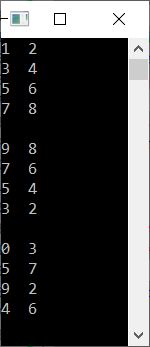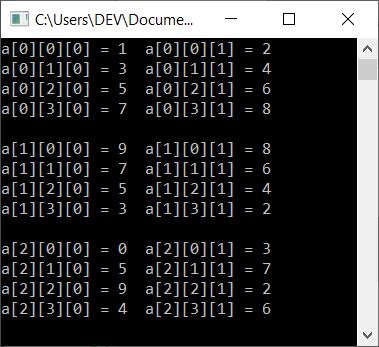- C++ Programming Examples
- C++ Programming Examples
- C++: Hello World
- C++: Get Input
- C++: Print Integer
- C++: Add two numbers
- C++: Add, Sub, Multiply, Div
- C++: Add Digits
- C++: Find Average and Percentage
- C++: Find Arithmetic Mean
- C++: Sum of n Natural Numbers
- C++: Sum of n Numbers
- C++: Square's Area and Perimeter
- C++: Rectangle's Area and Perimeter
- C++: Triangle's Area and Perimeter
- C++: Area and Circumference
- C++: Find Simple Interest
- C++: Fahrenheit to Celsius
- C++: Celsius to Fahrenheit
- C++: Print Prime Numbers
- C++: Reverse a Number
- C++: Swap Two Numbers
- C++: Print Multiplication Table
- C++: Find Factorial of a Number
- C++: Find Factors of a Number
- C++: Find HCF and LCM
- C++: Create a Calculator
- C++: Count Digits in a Number
- C++: First and Last Digit Sum
- C++: Product of Number Digits
- C++: Sum of Squares of Digits
- C++: Interchange Digits of Number
- C++ if-else Programs
- C++: Check Even or Odd
- C++: Check Prime or Not
- C++: Check Alphabet or Not
- C++: Check Vowel or Not
- C++: Check Leap Year or Not
- C++: Check Reverse equals Original
- C++: Check Perfect Number
- C++: Check Palindrome or Not
- C++: Check Armstrong or Not
- C++: Divisibility Test
- C++: Find Labor Wage
- C++: Find Discounted Price
- C++: Find Shipping Charge
- C++: Find Telephone Bills
- C++: Calculate Student Grade
- C++: Largest of Two Numbers
- C++: Largest of Three Numbers
- C++ Number Conversion
- C++: Decimal to Binary
- C++: Decimal to Octal
- C++: Decimal to Hexadecimal
- C++: Binary to Decimal
- C++: Binary to Octal
- C++: Binary to Hexadecimal
- C++: Octal to Decimal
- C++: Octal to Binary
- C++: Octal to Hexadecimal
- C++: Hexadecimal to Decimal
- C++: Hexadecimal to Binary
- C++: Hexadecimal to Octal
- C++ Pattern Programs
- C++: Pattern Programs
- C++: Print Diamond Pattern
- C++: Print Floyd's Triangle
- C++: Print Pascal's Triangle
- C++ Array Programs
- C++: 1D Array Program
- C++: Linear Search
- C++: Binary Search
- C++: Largest Element in an Array
- C++: Smallest Element in an Array
- C++: Find Second Largest Element
- C++: Find Second Smallest Element
- C++: Sum of All Elements
- C++: Multiply All Elements
- C++: Element in Even Position
- C++: Element in Odd Position
- C++: Print Even Numbers in Array
- C++: Print Odd Numbers in Array
- C++: Count Even or Odd Numbers
- C++: Sum of Even or Odd Numbers
- C++: Count Positive, Negative, Zero
- C++: Reverse an Array
- C++: Insert an Element
- C++: Delete an Element
- C++: Merge two Arrays
- C++: Bubble Sort
- C++: Selection Sort
- C++: Insertion Sort
- C++: Common Elements
- C++: 2D Array Programs
- C++: Add Two Matrices
- C++: Subtract Two Matrices
- C++: Transpose Matrix
- C++: Multiply Two Matrices
- C++: 3D Array Programs
- C++ String Programs
- C++: Print String
- C++: Find String Length
- C++: Compare Two Strings
- C++: Copy String
- C++: String Concatenation
- C++: Reverse a String
- C++: Delete Vowels from a String
- C++: Delete a Word from a String
- C++: Count Characters in a String
- C++: Count Words in a String
- C++: Frequency of Words
- C++: Remove Spaces from Strings
- C++: Sort a String
- C++: Uppercase to Lowercase
- C++: Lowercase to Uppercase
- C++: Swap Two Strings
- C++: Check the Anagram or Not
- C++: Capitalize All Words in a String
- C++: Get Numbers from a String
- C++ File Programs
- C++: Read a File
- C++: Write Content to a File
- C++: Append Data to a File
- C++: Read and Display File
- C++: Copy a File
- C++: Merge Two Files
- Count Characters in a File
- C++: Capitalize Every Word
- C++: List Files in Directory
- C++: Delete a File
- C++: Encrypt and Decrypt a File
- C++ Misc Programs
- C++: Print ASCII Value
- C++: Add Binary Numbers
- C++: Generate Random Numbers
- C++: Print a Smiling Face
- C++: Days into Years and Months
- C++: Add Two Numbers using Pointer
- C++: Print Fibonacci Series
- C++: Generate Armstrong Numbers
- C++: Find nCr and nPr
- C++: Get IP Address
- C++: Print Date and Time
- C++: Shutdown and Restart Computer
- C++ Programming Tutorial
- C++ Tutorial
C++ Three-Dimensional Array Programs
In this article, you will learn how to implement a three-dimensional (3D) array in C++ and get the code to do so. Here is the list of programs available in this article:
- Initialize and print a three-dimensional (3D) array
- Print the three-dimensional array with indexes
- Program to show how to access elements of a three-dimensional array
- Receive dimensions and elements for the 3D array from the user and print the array
Note: A three-dimensional (3D) array comes under the category of a multi-dimensional array. A multi-dimensional array is an array of arrays.
Note: A three-dimensional (3D) array is a collection of two-dimensional (2D) arrays.
Note: In a 3D array, there are three dimensions (subscripts). The first shows block size, the second shows row size, and the third shows column size. The dimensions of a 2D array are represented by the row and column sizes. The block size, on the other hand, indicates the number of 2D arrays. For example, if a 3D array's dimension is 3*4*2, it is a 3 2D array with 4 * 2 dimensions. Furthermore, it refers to a three-by-two-dimensional array with four rows and two columns.
3D Array Program in C++
This program initializes elements in a three-dimensional array named threeDimArr[][][] of size 3*4*2. After all 24 elements get initialized, we print the 3D array back on the output screen as shown in the program given below:
#include<iostream> using namespace std; int main() { int i, j, k; int threeDimArr[3][4][2] = { { {1, 2}, {3, 4}, {5, 6}, {7, 8} }, { {9, 8}, {7, 6}, {5, 4}, {3, 2} }, { {0, 3}, {5, 7}, {9, 2}, {4, 6} } }; for(i=0; i<3; i++) { for(j=0; j<4; j++) { for(k=0; k<2; k++) cout<<threeDimArr[i][j][k]<<" "; cout<<endl; } cout<<endl; } cout<<endl; return 0; }
This program was built and runs under the Code::Blocks IDE. Here is its sample output:

Note: As you can see, there are three 2-dimensional arrays of size 4*2. That is, each two-dimensional array contains 4 rows and 2 columns.
To print a 3D array, you have to use three for loops. The third for loop (the innermost loop) forms a 1D array, the second for loop forms a 2D array, and the third for loop (the outermost loop) forms a 3D array.
In other words, the block size is the outermost (first) dimension of the loop, the row size of the 2D array is the second, and the column size of the 2D array is the third.
Print three-dimensional array with their indexes in C++
This program is similar to the previous program. In addition to the job done by the previous program, this program prints all elements of a 3D array along with indexes. So this program also shows how elements get stored in a 3D array:
#include<iostream> using namespace std; int main() { int i, j, k; int a[3][4][2] = { { {1, 2}, {3, 4}, {5, 6}, {7, 8} }, { {9, 8}, {7, 6}, {5, 4}, {3, 2} }, { {0, 3}, {5, 7}, {9, 2}, {4, 6} } }; for(i=0; i<3; i++) { for(j=0; j<4; j++) { for(k=0; k<2; k++) cout<<"a["<<i<<"]["<<j<<"]["<<k<<"] = "<<a[i][j][k]<<" "; cout<<endl; } cout<<endl; } cout<<endl; return 0; }
The snapshot given below shows the sample output produced by this C++ program on a three-dimensional array:

Access and print elements of a three-dimensional array
Now this C++ program shows how the elements of a 3D array get accessed. In this program, we've accessed three elements of a 3D array using its index.
#include<iostream> using namespace std; int main() { int i, j, k; int a[3][4][2] = { { {1, 2}, {3, 4}, {5, 6}, {7, 8} }, { {9, 8}, {7, 6}, {5, 4}, {3, 2} }, { {0, 3}, {5, 7}, {9, 2}, {4, 6} } }; cout<<"a[0][1][0] = "<<a[0][1][0]<<endl; cout<<"a[1][3][0] = "<<a[1][3][0]<<endl; cout<<"a[2][0][1] = "<<a[2][0][1]<<endl; cout<<endl; return 0; }
Here is its sample output:

Note: In the above program, a 1D array of two elements is constructed first. Then four such 1D arrays are placed one below the other to give a 2D array containing four rows. Then, three such 2D arrays are placed one behind the other to yield a 3D array containing three 2D arrays.
Receive 3D array elements from the user
This program allows the user to enter the dimension and then elements for a 3D array. Based on user inputs, we've printed the 3D array back on the output screen:
#include<iostream> using namespace std; int main() { int i, j, k, a[10][10][10]; int one, two, three; cout<<"Enter the Dimension of 3D Array: "; cin>>one>>two>>three; cout<<"Enter "<<one*two*three<<" 3D Array Elements: "; for(i=0; i<one; i++) { for(j=0; j<two; j++) { for(k=0; k<three; k++) cin>>a[i][j][k]; } } cout<<endl; for(i=0; i<one; i++) { for(j=0; j<two; j++) { for(k=0; k<three; k++) cout<<a[i][j][k]<<" "; cout<<endl; } cout<<endl; } cout<<endl; return 0; }
Here is its sample run with user input, 2, 3, 4 as dimensions, and 1, 2, 3, 4, 5, 6, 7, 8, 9, 10, 11, 12, 13, 14, 15, 16, 17, 18, 19, 20, 21, 22, 23, 24 as 24 3D array elements:

The same program in different languages
« Previous Program Next Program »